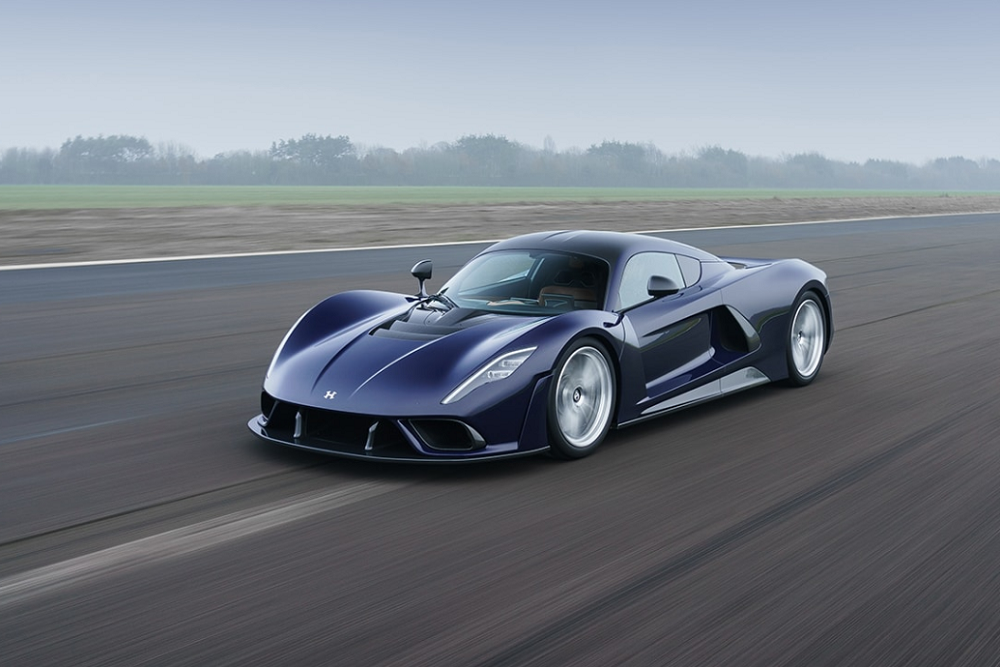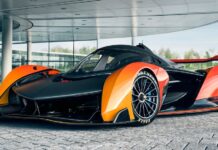The Venom F5 is an all-new hypercar designed and built from the ground up with one goal in mind: To be the absolute fastest road car on earth.

Hennessey and team have developed a completely new design, chassis and carbon fiber body focused on aerodynamics to achieve the lowest possible drag. The exterior of the F5 is shaped by aerodynamics and inspired by the pursuit of speed. The entire car exudes determination, purpose and drama from every direction with sculpted aerodynamic ducting and sharp, powerful lines to give the car a real sense of speed and intent, even while stationary.
“The customers from Hennesee love speed, so they’re fired-up to push the boundaries of what’s possible to attempt the world’s fastest production car record, but the Venom F5 is about more than just speed and power. This car will handle superbly, quality is exceptional, there are more than 3,000 bespoke parts, materials are exquisite, everything is a fitting tribute to 30 years of the Hennessey brand.”
The rear-wheel drive F5 produces 1,817 hp and weighs a mere 1,360 kg (2,998 lb). These facts combine to deliver a power-to-weight ratio of 1.34 hp-per-kg (1,298 hp-per-ton) – well in excess of any road car on sale today. As a key strength of the F5, its tremendous power and lightweight construction help to shape the extreme, visceral and untameable nature of the F5 as an unstoppable force in the hypercar world.
The F5 is powered by a rear-mid-mounted 6.6-liter twin-turbocharged V8 engine that generates 1,817 hp at 8,000 rpm. This power, 277 hp/liter, in a car that weighs just 1,360 kg (2,998 lb) generates a power-to-weight ratio of 1.34 hp/kg (1,298 hp/ton) – the highest of any road car.
Power & Performance (Specifications)
After an extensive engineering and development phase, the Hennessey team has done it again.
The Venom F5 is a symphony of mind-bending numbers, but that’s not the whole story. The car’s dynamics have been developed by Hennessey’s in-house dynamics guru – legendary US racing driver and vehicle set-up expert John ‘Heinrocket’ Heinricy. During the car’s development, his input will ensure that F5 offers a world-class all-round driving experience on road and track.
The F5 aims to exceed 500 kph (311mph) on a two-way validated speed run using a production specification car. The record attempt will be independently verified by the world-renowned experts from Racelogic using VBOX GPS data acquisition systems. Racelogic / VBOX engineers will be on site to install, test and calibrate the speed testing equipment in the F5 to ensure absolute accuracy and transparency. In addition, VBOX engineers will verify all test data and final speed numbers. The speed test will be attended by independent witnesses, media guests and F5 customers. GPS data and uninterrupted video footage will also be made publicly available following the speed test.
The rear-wheel drive F5 produces 1,817 hp and weighs a mere 1,360 kg (2,998 lb). These facts combine to deliver a power-to-weight ratio of 1.34 hp-per-kg (1,298 hp-per-ton) – well in excess of any road car on sale today. As a key strength of the F5, its tremendous power and lightweight construction help to shape the extreme, visceral and untameable nature of the F5 as an unstoppable force in the hypercar world.
Key to the F5’s development, is making the driver feel perfectly in-tune with the car while delivering exhilaration and rewarding handling characteristics. The F5’s development will produce a car that inspires driving confidence at all speeds with the accuracy and feedback-rich responses of a race car. Every part of the new model will be touched by Heinricy and his team, whose exacting standards will ensure the F5 offers a world-class driving experience.
The Fury is a 90-degree push-rod cross-plane crank V8 engine that weighs 280 kg (617 lb). Using all 30 years of the Hennessey team’s knowledge, the bespoke unit features an all-new cast iron block and aluminium cylinder heads and runs an aggressive road cam providing a characteristic off-beat race car sound and feel. Each engine is hand-built with precision components crafted from high-grade metals including aluminium, titanium and Inconel. These include the crankshaft, pistons, valves and connecting rods.
Driver Focused (F5 Cockpit)
The interior design of the F5 is simple, lean and elegant. Designed to evoke the spirit of fast aircraft cockpits, the space exhibits minimal distractions, while promoting maximum driver visibility tactility and functionality.
On the inside the F5 proudly exhibits premium simplicity, there is nothing inside the car that is peripheral to the act of driving. This is helps to save weight, and to promote total driver focus – just like a pilot sitting in a fighter jet cockpit. The interior is true to the car’s roots displaying raw carbon fibre throughout, but with hints of luxury from leather panels on the doors, dashboard and seats.
As the driver opens the F5’s butterfly door, they are greeted with a bespoke carbon fibre steering wheel, which is inspired by an aeroplane ‘yoke’ and an F1 racing car’s steering wheel. To maximise driver visibility of instrumentation and the road ahead, the top of the wheel is eliminated, while also encouraging proper hand placement for optimal steering wheel control. The parts of the steering wheel where the hands naturally grip, are leather-clad, the rest is exposed carbon-fibre. On the wheel are tactile controls for lights, windscreen wipers and turn signals, while in the centre sits a green switchable mode dial that lets the driver select from Sport, Wet, Drag, Track, and F5 modes.
Behind the wheel on the top of the steering column sits a 7.0-inch instrument display cluster. Inspired by the head-up display screen in a jet fighter, the screen changes with each drive mode, displaying a different colour and content layout. At all times the screen displays vehicle speed and engine revs alongside oil, coolant and engine temperatures.
The carbon fibre bucket seats are cushioned with leather-clad pads that adhere to the ‘function defines form’ design philosophy and contribute to a lighter seat. The F5 accommodates two people in comfort providing optimum support for cruising or faster cornering. They both cosset the occupants during spirited driving and provide comfortable support under extreme acceleration and at high speed.
The interior surfaces are a balance of leather and satin-finish carbon fibre. The dashboard features leather and aluminium inserts overlaid on the exquisitely finished carbon fibre. On each door panel sits a lightweight carbon fibre door handle that ‘floats’ above the leather highlighting the union of optimal performance and luxury. The door handles are accented by aluminium inserts that depict the Texas and US flags, clearly communicating the car’s proud American heritage.
Seated in the cabin the driver is surrounded by a belt of gloss carbon fibre, which subtly contrasts with the satin carbon fibre and leather. Looking around the cabin the driver’s eyes are naturally drawn down to the slimline carbon fibre centre console upon which sit the function buttons for the windows, hazard lights, parking brake, vehicle lift system and door locks.
As the eye follows the centre console up the dashboard, there are three simple circular buttons for gearbox operation ‘N’, ‘D’ and ‘R’ above which sits a tactile circular controller with a 1.3-inch digital screen set within it, which is used to adjust the car’s HVAC systems. Touch screen activation paired with a rotating machined aluminium bezel allows the temperature, airflow and intensity to be adjusted. As the centre console accelerates upwards towards the dashboard, two circular air vents are visible, stacked one above the other.
Above the central vents sits a 9.0-inch Alpine touchscreen infotainment system. This gives the driver and passenger access to Apple Car Play and Android Auto with satellite navigation, stereo functionality and Bluetooth phone pairing for hands-free phone and multimedia use. The integration of Apple Car Play and Android Auto future-proofs the F5’s infotainment interface to ensure the system always remains up-to-date.
The leatherwork is supplied by Muirhead, one of Europe’s oldest tanneries. It is applied to hand-crafted interior trim alongside touches of Alcantara, which covers the headlining and stowage compartments to add a further hint of luxury and help manage interior sound levels.
The first Venom F5 is a customer car and is trimmed to their specification in ‘Butterscotch’ leather with black leather and Alcantara accents. There are also a few touches of green in the car, which are placed as a nod to the mantra ‘green means go’. Green is also accented on the ‘drive’ button, the mode selector on the steering wheel, and is accented in leather on the seat bolster – all of which are areas that the driver interacts with directly.
The F5’s pedals are machined from solid aluminium, providing yet another touchpoint that exudes quality and is reflective of the lightweight nature of the F5. The accelerator pedal is narrow and floor-hinged, while the brake pedal is wide and hinged from above. In the passenger footwell, there is a small compartment that stores a tool kit by default, but customers can also personalise the storage space to meet their own requirements.
Ultra-Lightweight (Carbon Fiber Chassis)
At the core of the F5 is an ultra-lightweight carbon fiber monocoque that tips the scales at just 86kg.
This achievement sets the tone for the rest of the car where lightness features in every component to achieve the 1,360kg total dry vehicle weight.
The all-new Hennessey designed carbon chassis features an intricate carbon weave in a herringbone pattern down the centre line of the car. Moulding the carbon fiber interior and exterior parts required more than 600 separate bespoke pieces of tooling. During the car’s three-year engineering development significant time has been spent on perfecting the chassis and body of the car to achieve lightness, leading torsional rigidity, and purpose-led beauty.
The exterior body panels are also constructed from high-strength carbon fiber for weight saving. The lightweight doors and door sills highlight the extent of carbon fiber engineering that features on the F5. By integrating the sills as part of the door structure, the Hennessey team avoided the ingress and egress challenges of some other hypercars.
The carbon fiber tub also plays an important structural role, which is clear to see within the engine bay. Here, a pair of substantial braces link the double wishbone suspension directly to the monocoque. This transfers forces to the exceptionally rigid carbon fiber shell, aiding to the car’s stability, road holding and predictable handling even at high speed and under extreme cornering loads.
The intrinsic strength of carbon fiber enhances occupant safety in the event of an accident. The carbon fiber body joins an aluminum subframe where engine and suspension components connect. The subframe components are engineered to deform in the event of an accident to absorb the energy of an impact and protect the passenger cell.
Report by hennesseyspecialvehicles.com










